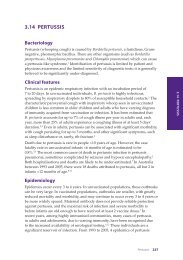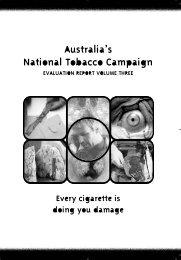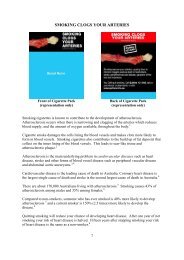Review of the management of adverse effects associated with ...
Review of the management of adverse effects associated with ...
Review of the management of adverse effects associated with ...
Create successful ePaper yourself
Turn your PDF publications into a flip-book with our unique Google optimized e-Paper software.
safety monitoring and investigation into <strong>adverse</strong><br />
events following 2010 seasonal influenza vaccination<br />
in young children (TGA 8 October 2010).<br />
Work commenced immediately and involved <strong>the</strong><br />
establishment <strong>of</strong> a TGA expert scientific advisory<br />
panel and a joint ATAGI–TGA Working Group,<br />
supported by <strong>the</strong> ATAGI Secretariat in OHP. The<br />
Working Group developed templates for data<br />
collection for <strong>the</strong> epidemiological analyses and<br />
provided <strong>the</strong>m to all jurisdictions on 26 April 2010.<br />
All jurisdictions collected and provided data on<br />
febrile convulsion presentations to emergency<br />
department, vaccine distribution, batch numbers<br />
and clinical data for <strong>the</strong> validation <strong>of</strong> cases. The<br />
NCIRS undertook <strong>the</strong> epidemiological analyses<br />
in consultation <strong>with</strong> <strong>the</strong> ATAGI–TGA Working<br />
Group. The TGA also established an expert<br />
panel on vaccine testing, chaired by Pr<strong>of</strong>essor<br />
Peter Doherty, to advise on <strong>the</strong> laboratory<br />
investigations. The expertise <strong>of</strong> <strong>the</strong> TGA and<br />
its advisory committees and <strong>the</strong> AHPC all<br />
contributed to <strong>the</strong> investigation.<br />
Throughout <strong>the</strong> period <strong>of</strong> <strong>the</strong> investigation, <strong>the</strong><br />
CMO liaised regularly <strong>with</strong> state and territory<br />
health <strong>of</strong>ficials, TGA, ATAGI, and general practice<br />
and o<strong>the</strong>r immunisation provider organisations<br />
to facilitate rapid exchange <strong>of</strong> clinical and<br />
epidemiological data and dissemination <strong>of</strong> <strong>the</strong><br />
findings as <strong>the</strong>y became available. The CMO also<br />
held regular briefings to keep <strong>the</strong> community<br />
informed.<br />
Comment<br />
It is apparent from <strong>the</strong> document review<br />
that <strong>the</strong>re had been a sense among health<br />
pr<strong>of</strong>essionals and parents in WA and SA that<br />
<strong>the</strong>re was something unusual about <strong>the</strong> <strong>adverse</strong><br />
events pr<strong>of</strong>ile <strong>of</strong> <strong>the</strong> 2010 seasonal flu vaccine<br />
from soon after <strong>the</strong> start <strong>of</strong> <strong>the</strong> vaccination<br />
programs in <strong>the</strong>se two jurisdictions. However,<br />
this did not translate quickly into formal<br />
reports <strong>with</strong> hard data suitable for confirming<br />
<strong>the</strong> presence <strong>of</strong> a signal. At <strong>the</strong> time that <strong>the</strong><br />
immunisation coordinators in WA and SA were<br />
asking for information, TGA had received a small<br />
number (4) <strong>of</strong> reports <strong>of</strong> febrile convulsions.<br />
The records indicate that many jurisdictions<br />
were not forwarding reports as <strong>the</strong>y were<br />
received, but were batching <strong>the</strong>m. In some<br />
cases, an AEFI report was sent but did not<br />
mention a febrile convulsion, which was only<br />
identified later during <strong>the</strong> investigation.<br />
The majority <strong>of</strong> febrile convulsion reports were<br />
received by TGA only after <strong>the</strong> jurisdictions<br />
had been prompted to send reports because<br />
<strong>of</strong> <strong>the</strong> concerns being raised by WA and SA.<br />
Almost all reports were received by TGA after<br />
19 April 2010.<br />
There also appeared to be some confusion<br />
about what constitutes an AEFI report, when it<br />
is possible to determine that <strong>the</strong>re is a potential<br />
signal, and <strong>the</strong> subsequent determination <strong>of</strong><br />
causality and action to be taken. The <strong>Review</strong><br />
considers that, while emails and phone calls<br />
between health pr<strong>of</strong>essionals are a way <strong>of</strong><br />
alerting each o<strong>the</strong>r to <strong>the</strong> possibility that<br />
<strong>the</strong>re is a potential problem, <strong>the</strong>y do not in<br />
<strong>the</strong>mselves constitute confirmation <strong>of</strong> a signal.<br />
Properly documented and timely case reports<br />
are needed before a signal can be confirmed<br />
and appropriate action be taken. Investigation<br />
<strong>of</strong> a signal is a complex process involving<br />
confirmation/validation <strong>of</strong> <strong>the</strong> cases, active<br />
looking for unreported cases, estimation <strong>of</strong><br />
rates and fur<strong>the</strong>r epidemiological and o<strong>the</strong>r<br />
investigations (Global Advisory Committee on<br />
Vaccine Safety 2009).<br />
28<br />
<strong>Review</strong> <strong>of</strong> <strong>the</strong> <strong>management</strong> <strong>of</strong> <strong>adverse</strong> events <strong>associated</strong> <strong>with</strong> Panvax and Fluvax







